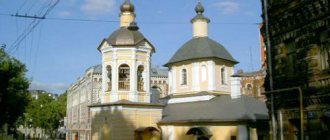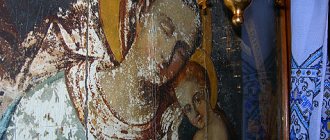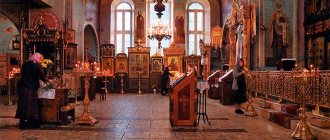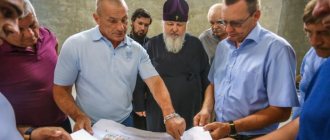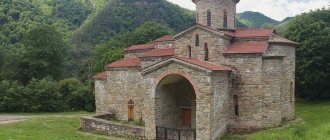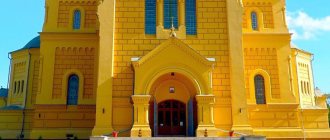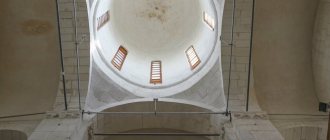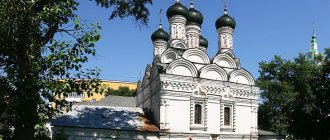Not all excursions in Arkhyz are limited to walks in the mountains and viewing waterfalls. There are also cultural treasures here that have reached our time through centuries. One of these cultural heritage sites is the Nizhne-Arkhyz settlement, located near the village of Nizhniy Arkhyz. This is an architectural monument of the X-XII centuries. This place has another name associated with the people who built these temples. These are Alans, and this place is appropriately called the Alan settlement. Near this place there is another attraction that we will definitely visit, this is the “Face of Christ”.
How to get to Alan temples
Nizhny Arkhyz is located 25 km from Arkhyz along a gorge with only one road, so when leaving Arkhyz you don’t have to worry about missing a fork or taking a wrong turn. If you are driving a personal vehicle from Arkhyz, then you need to turn right near the sign for the SAO RAS, cross the bridge over the Bolshoi Zelenchuk River and now you are at the entrance to the territory of the Alan settlement. If you are coming from the village of Zelenchukskaya, then you need to turn left accordingly.
In addition to personal vehicles, you can get to the Alanian temples by public transport from the village of Romantik or from Arkhyz. Buses run on schedule, but there are no more than 5-6 routes per day, so you shouldn’t rely on luck and it’s better to check the schedule at the hotel.
In addition to the above, you can look at the Alan settlement in another way, take an excursion from the KMS, if you do not live in Arkhyz or Romantika. Such an excursion has many disadvantages. The most significant is that from the nearest city of the KMV - Kislovodsk, the path to Nizhny Arkhyz will be 156 km, which is equivalent to a 3-hour ride by excursion bus. From which we can conclude that this excursion will take about 10 hours, 6 of which will have to be spent in the bus seat. The remaining time will be distributed between visiting the Alan settlement, the face of Christ and the RAS observatory. Time will also be allocated for lunch, so it is possible that one of the attractions will be excluded from the excursion; as a rule, a visit to the Observatory will be sacrificed.
Cherkessk
Our path ran through the city of Cherkessk (founded in 1825 as the village of Batalpashinskaya) - the capital of the Karachay-Cherkess Republic. The town is small with a population of just over 122,000 people, but is quite famous for its private automobile plant Derways, where Lifan, Haima, Geely, and Great wall Hover cars are assembled. Also on the territory of Cherkessk there are many beautiful mosques, and not far away there is a brewery in the city of Karachaevsk on the banks of the Teberda.
Cherkessk
Mosque. Cherkessk
At a sanitary stop when leaving the city along the Pyatigorskoye Highway, we met such a beauty - a black and white sociable cat with yellow eyes. 
Beauty cat
Here is a very modest memorial to the victims of the Great Patriotic War. According to historical reports, thousands of Circassian civilians were killed by the Nazis in 1942 by poisoning them with exhaust gases in special machines (the Germans called them “bakeries”, “gas chambers” and “fly swatters”). The occupation of Cherkessk by German invaders lasted six months - from August 1942 to January 1943.
Monument. Cherkessk
Many people don’t even know about such a monument, they throw away cigarette butts, etc. Locals collected signatures to improve the monument, but to no avail.
Monument. Cherkessk
Alan settlement
The Nizhne-Arkhyz settlement, named after its location, is an architectural monument of the 10th-12th centuries. This complex historical monument has survived to this day, represented by three buildings and several stone sculptures; they are located within walking distance of each other, which makes it possible to combine these objects into a single historical complex.
Not many people are interested in history, but having been here it is impossible not to become interested in the history of these temples, which are already 1000 years old. The surprising thing is that the original religion for the Caucasian regions is traditionally Islam, but here we are looking at a Christian temple, and even built a thousand years before us. Of course, the close proximity of Ciscaucasia to the Byzantine Empire thus influenced the development of religion. But even though Christian churches appeared among the Alans in the 10th century, they very soon fell into disrepair, and the civilization itself was destroyed two centuries later by the Mongols. The Ossetians are considered to be the successors of the Alans, but all the monuments of Alan architecture are located on the territory of Karachay-Cherkessia.
Entrance to the territory of the historical complex is paid, the cost is 150 rubles per person, children from 7 to 14 years old - 50 rubles , under 7 years old free . There is a dirt road leading to the last temple, so if you wish, you can drive here by car, but you will have to check the prices for entry yourself.
The inscription on the memorial stone reads: “To the creators of the great Alan culture from the descendants - the Karachais and Balkars,” however, as was said earlier, the Ossetians are considered the descendants of the Alans, since they belong to the same Iranian-speaking language group, while the Karachais and Balkars are the heirs of the Turkic language group.
After a short pedestrian crossing, we find ourselves at the stone idol. This is a stone statue of a Turkic warrior, whose gaze is directed along the course of the Bolshoi Zelenchuk River.
Further the road forks. It would be better to use the path going to the right and return along the left path. Turning onto the right road we immediately find ourselves in an abandoned village. Not the most pleasant of feelings, considering that we came here on our own and there was no one here except us.
Interesting Facts
More than 80 nationalities live in tiny Cherkessk with a population of just over 120 thousand people.
- The products of the Circassian confectionery factory "Dakhanago" are very popular in all cities of the Caucasian Mineral Waters.
- The religious capital of Western Alania and the residence of the Metropolitan, who was among the highest hierarchs of Constantinople, was located on the territory of modern Lower Arkhyz.
- In 2014, the Arkhyz resort was included in the Russian Book of Records as “The shortest time to create a regional media holding from scratch.”
- The radio astronomy telescope, installed 8 km from the village of Zelenchukskaya at an altitude of 970 meters above sea level, is the largest in the world.
Arkhyz
Arkhyzmountain of ChristRussiaNorth Caucasus
South Temple
But these are not just abandoned buildings. These are also cultural heritage sites. The fact is that one of the Alanian temples underwent complete reconstruction. Currently, this is the Church of St. Elijah and is the oldest existing temple in Russia. Built in the 10th century, the church was dedicated to the holy prophet Elijah, and at the last illumination of the church, the name was preserved. The church was rebuilt by monks in the 19th century, they also founded the Alexander Nevsky Monastery, the buildings of which have now fallen into disrepair. There are three temples in the Nizhne-Arkhyz settlement; this temple is also called the South. In addition to it, there is also Middle and North. They are called that for convenience, and they are named that way because all three temples are located on the same straight line, located from southwest to northeast.
On weekends, when excursions from the KMV are brought here, mountain tea tasting opens here.
Near the small pond there are several more exhibits from the archaeological excavations.
Complex "Arkhyz"
And, finally, the final goal of the route is the Arkhyz complex (more precisely, its full name is the All-season tourist and recreational complex “Arkhyz”).
Complex "Arkhyz"
When we arrived, it was just the end of the ski season (beginning of April). But I wasn’t interested in skiing (unfortunately, I don’t know how to ski). The goal was to wander through the snow-capped mountains.
Inside the complex itself there are also a lot of different souvenirs, including handmade dolls and nesting dolls with Caucasian flavor. The design of the complex itself and the cable car cabins very much reminded me of the design of everything in the resort village of Krasnaya Polyana in Sochi (perhaps the ideas were picked up there).
Complex "Arkhyz"
Souvenirs
Souvenirs
As for the cable car, there are now 2 types of cable cars in Arkhyz: “Sputnik” and “Milky Way”.
Cable car to Arkhyz
Cable car ride up
I went up on the closed cable car “Milky Way” and... immediately found myself in deep winter.
Arkhyz. Upstairs)
True, the snow has already begun to melt and small “lakes” have formed here and there. Although the screen showed -1°C, it felt much colder. We drank a glass of mulled wine at a local cafe and went for a walk...
Cable car station
Cafe Arkhyz
Beauty…
The snow is already melting
The last skiers climbed higher...
Arkhyz. Skiers
Middle Temple
Coming out of the shade of the trees, we find ourselves in an open space that adorns the Middle Alan Temple. The middle Zelenchuk temple dates back to the 9th century. The architect who built it observed not only proportions, but was also guided by Byzantine architectural styles, making the temple in the shape of a cross. This temple, like the Northern Temple, was restored by monks in 1897.
Northern Temple
From the Middle Temple the path takes us to the Northern Temple.
The northern temple is the largest and is located at a distance from the main buildings. The Northern Temple was built according to all the rules of medieval architecture. The temple is a cross, with a dome in the center of the cross. The altar is located in the eastern part, as it should be according to the canons. The width of the temple is half its length, while the length of the temple corresponds to its height. From the north, south and west, the temple has open porches leading into the temple. The temple, like all the others, was assembled from sandstone slabs, and held together with a very resistant limestone mortar.
Behind the temple there is a forest, if you go a little deeper into it you will notice a rock with a rounded stone sticking out of it.
On the way back we will not go past the Middle Temple, but will take the right path.
On the way back there is another monument of ancient architecture. This is an ancient calendar. Scientists came to this conclusion quite recently, and at first they acted by exclusion. During excavations, a circle with a diameter of about 90 meters was discovered. Such a large circle could not have been covered with a roof and was unlikely to be used as a fortress. Very recent studies carried out in the circle showed that the behavior of the sun relative to the circle corresponds to the Byzantine calendar, from which the corresponding conclusion was drawn.
Returning along the right path, if you look carefully, then on the rock behind the river you can see the next point of our excursion - the Face of Christ.
Face of Christ in Arkhyz
It will take no more than 2 hours to go around all the buildings and return to the beginning, and the distance traveled will be 5-6 kilometers. That is why it is better to combine a visit to the Alan settlement with a visit to the nearby attraction “The Face of Christ”.
After visiting the Alan settlement, getting to the “Face of Christ” will not be difficult at all. You need to cross the bridge over the Bolshoy Zelenchuk River and move along the highway to the right towards the village of Zelenchukskaya. Just around the bend you will see a church on one side of the road and a market on the other.
Here you can have a snack after traveling through the Nizhne-Arkhyz settlement, replenishing your strength with khychyns and mountain tea. There is also a public transport stop here, from which we will go back to Arkhyz. But there is an important feature. Although the minibuses run on schedule, they travel quickly and if you don’t have time to wave your hand, they can pass by. Therefore, if you see a minibus, be sure to vote!
It would be easy to miss the trail on the route, but in 2008 the Temple of the Miraculous Image of the Lord Jesus Christ was opened nearby. In 2011, a route was opened with a 345-meter staircase, which has 526 steps. The face itself was discovered in 1999 and pilgrims and tourists had to climb a very steep slope for 12 years. The appearance of the stairs made the passage of this route comfortable and fast - the ascent and descent will take you 1 hour.
The “face of Christ” itself is written on a rock facing east, so it looks at the Elijah Temple - the Southern Temple. Many myths and mysteries have already gathered around the origin of the face. And although the fresco is still being analyzed, historians have tentatively dated the icon to the 9th century.
At the end of the route there is a platform where you can rest. It is prohibited to climb closer to the Arkhyz face. From the same platform there is a view of the Nizhne-Arkhyz settlement, well, it almost opens, we know that it is there.
Going down the steps, we had a view of the Special Astronomical Observatory of the Russian Academy of Sciences (SAO RAS), which is located on Mount Pastukhov. There are also excursions there, but it will be difficult for independent tourists to get there. If you walk, the distance to the observatory from the highway where the Nizhne-Arkhyz settlement is located will be 6 km, and the elevation gain will be 950 meters.
If you have personal transport, in addition to the above, you can climb the mountain serpentine to inspect the observatory and admire the opening panorama of the mountains. The entire excursion to the Nizhne-Arkhyz settlement, the ascent to the “face of Christ” and the inspection of the SAO RAS will take you about 5-6 hours. This excursion may not be mandatory to get acquainted with the beauties of the Caucasus and Arkhyz in particular, but you won’t find a better excursion to get acquainted with the history of the region.
Traveling around Russia
The Alan settlement is located in the Arkhyz mountain area, on the right bank of the Bolshoi Zelenchuk River. I’ll say right away that Arkhyz is a capacious name. This is the mountainous area in Karachay-Cherkessia in the Western Caucasus, this is the village of Arkhyz and the Arkhyz ski resort, located on the eastern slopes of the Main Caucasus Range. This is the Arkhyz River, a tributary of the Psysh River, which flows into the Bolshoy Zelenchuk River, carrying its waters through the area.
Miraculous Image of the Face of Christ
We began our journey around Arkhyz with a visit to the Miraculous Image of the Face of Christ, located to the right of the road on the slope of Mount Mytseshty at an altitude of over one hundred meters. At the entrance we saw these two signs, after reading which we immediately became imbued with the holiness of this place.
A long metal staircase of 525 steps leads to the Miraculous Image. On the rise there are several areas with benches for relaxation. We got up in 10-15 minutes. Of course, it was a tough climb. But there is no easy road to God.
Face of Christ
And here we are at our goal. What I saw fascinated me. Goosebumps ran through my body. From the depths of centuries Christ looked at us. It is unknown who depicted the Face of Christ on the rock. There is an assumption that this was done by the first monks who settled here back in the 10th century. In those days, Christianity was not particularly revered in these places. There is an assumption that in this place there was one of the first Christian cells, in which monks settled far from pagan villages.
This image was found by two brothers Sergei and Valery Varchenko, who were hunting in these places. They reported this to archaeologists some time later. Chemical analysis of Face showed that he was painted with organic paints of three colors: dark red, brown and white. When drawing, the color of the rock itself was also used.
The Face was painted according to the Byzantine canons of icon painting of the 9th-11th centuries. For many years Lik was inaccessible. Being in a hard-to-reach place, it was also hidden from view by dense vegetation.
One fact speaks about the miraculous nature of the Face. One woman who lived in the village of Nizhny Arkhyz once turned to the Face of Christ. She asked him to heal her from infertility, and God sent her a child. A month later she became pregnant.
There is information that in these places there is also the face of the Virgin Mary, painted in a similar way. Now this place is classified.
From the Face of Christ we went to the Alan settlement, located opposite, on the other bank of the Bolshoi Zelenchuk River. From the opposite bank you can see the place where the Holy Face is located.
Here it is, just to the left of the center of the photo, between the trees.
Alan ancient settlement
Currently, it is an open-air archaeological monument of the 10th-12th centuries. It is the remains of a large settlement located not far from the village of Nizhny Arkhyz in Karachay-Cherkessia. According to scientists, this ancient city was the capital of the Alanian state - Magas or Maas. Do not confuse it with the current capital of Ingushetia, Magas - these are completely different cities. The ancient village existed until the 12th century, until the troops of the Tatar-Mongol horde came here.
At the end of the 19th century, in order to preserve the remaining churches and renew Christianity among the local population, the Alexander Nevsky Athos Zelenchuksky Monastery was created on the territory of the settlement.
When we arrived here, the terrain of the settlement was completely uneven. There were small mounds and depressions all around, overgrown with grass. As we were later told, these irregularities are the walls and foundations of ancient buildings covered with time. The first impression was not very good. Why not dig them up and leave them on display for tourists? But local workers said that they would be better preserved this way for posterity.
Phallic idol
This phallic idol was installed on the territory of the settlement in our time. I have never been able to find out where he was found. On the back side of the stone we saw an image of the face of a Turkic warrior.
There is no doubt that this symbol belongs to pagan culture. I also could not find any information about him. If anyone knows, please write in the comments.
Ancient astronomical calendar
The Alan settlement has impressive dimensions. It stretches for 4.5 kilometers along the Bolshoy Zelenchuk River. For the first time, attention was paid to its ruins at the beginning of the 19th century. Since then, many expeditions have carried out excavations here. Drop by drop, the fort revealed its secrets. The last large-scale excavations were carried out here during Soviet times from 1961 to 1978. As a result of the excavations, entire sections of the settlement were uncovered: residential, utility and industrial premises, and the remains of Christian churches and chapels were discovered, at which there were burials with things from the 10th to 12th centuries. An ancient observatory was also found here, which was used to determine the time of the summer and winter solstices, as well as the periods of the spring and autumn equinox.
It was interesting to walk around the ancient ruins of this circle. How many times have you seen these stones? Being here, we felt the breath of history.
If you look closely, you could see the outline of this circle with a diameter of 88 meters. The shape of a perfect circle, according to scientists, suggests a connection with the ancient cults of fire and the sun. It is known that the ancient Caucasian tradition of sun worship, expressed in the construction of circular stone structures, goes back to the Bronze Age.
Scientists found the center of the circle, where they installed a mark - this column, which was nicknamed the “Navel of the Earth”.
Northern Temple
Not far from the ancient observatory stands the Northern Temple. It was restored relatively recently - in the 50-60s of the twentieth century. What it looked like before restoration can be seen in the photo below.
I approached this temple with trepidation. After all, this is a monument to the history of the 10th century - the time of the baptism of the Alans in 916 AD. Yes, yes, from this trip I learned that the Alans, it turns out, were baptized 80 years earlier than Rus'.
After the restoration of the temple, local Christians did not like much about it. They would like to see the temple in its original form, but this did not happen. The restored arch over the entrance is made of red brick - there was no red brick in those days.
The roof is covered with tiles - there were no tiles then.
Well, what can you do - there is a temple and nothing can be done about it. The entrance to the temple is open and you can visit it freely, which is what we did.
Walking through these doors, I felt like I was moving into a time machine into the past. As soon as the door closed behind me, I felt like I was in the 10th century.
The restoration of the temple did not affect its inner spirit. And he was felt very strongly here. Either the unusual place of the altar, or the unusual windows, or the unsmooth plaster on the walls made you think that you were not in the 21st century.
Just looking at the floor, you return to reality, well, there were no such cement tiles in the 10th century. As I understand those Christians who did not like the latest restoration of the temple. Well, what can you do, every time makes its contribution to history. In 500 years, this tile itself will become history.
I walked around this temple alone and did not believe what was happening. I looked at these old walls with surprise and it seemed to me that they were looking at me with the same surprise. 11 centuries surrounded me on four sides.
Alanya converted to Christianity here
Several ancient burials were found here. Based on the results of these excavations, scientists concluded that the temple was visited mainly by the Alan elite, that is, people in power.
The grave of an Alan princess wearing expensive clothes and a lot of gold jewelry was excavated here. You can see it today in the historical museum in Moscow.
Having excavated this stone structure in the left corner of the temple with an outflow for water, scientists concluded that it was nothing more than a font. What is the font for - for baptism.
If this temple was visited by the Alan nobility, then she was baptized here. And since nobility was baptized, then the entire people were considered baptized.
And hence the conclusion that this particular temple is the cradle of Christianity in ancient Alanya. This, it turns out, is where we ended up.
As a result of historical research, it was found that the Northern Temple was consecrated in honor of St. Nicholas the Wonderworker. They decided not to give the temple to the church, since it is of historical value. Meanwhile, the service in the temple is still being conducted. Once a year, on May 6, a service is held here in memory of St. George the Victorious.
Middle Temple
Relatively close to the Northern Temple there is another temple from the early 10th century. The beginning of its construction dates back to the 920s AD, that is, after the Alans adopted Christianity at the beginning of the 10th century.
The temple has been quite well preserved to this day. Scientists have found out that this temple was built as a funeral and memorial for Alanian rulers and church hierarchs, however, over time, this function passed to the Northern Temple.
The middle church became the cathedral of the Alan Metropolitanate. and was used mainly by the simple population of the ancient Meuse. A large necropolis arose around the temple.
In the 19th century, the monks added two rooms to the temple, symmetrically to the left and right of the main entrance. They are clearly visible in this photo. The monks consecrated the temple, adapted for services, in honor of the Holy and Life-Giving Trinity.
When we went inside, we saw that the atmosphere here was somewhat different than in the Northern Temple. The plaster was almost completely missing. Nevertheless, the temple amazed with its grandeur.
While still under the impression of what I saw in the Northern Church, in the Middle Church I again plunged into the 10th century. Here, material values seem to materialize spiritual values again. My head involuntarily imagines pictures of ancient services in this temple, voices and sounds accompanying it.
South Temple
The third monument of the 10th century that has survived to this day is the Southern Temple. It is located on the territory of the Monastery and the most amazing thing is that it turned out to be operational.
There is a version that it belonged to the estate of a representative of the then nobility. The privacy of the temple is emphasized by its small size. The temple was consecrated in honor of St. Nicholas the Wonderworker.
I entered this old church with trepidation. It was a small, cramped room, but inside there was such a feeling of prayer that, involuntarily, I wanted to read the “Our Father” prayer. I didn’t even ask permission from the temple attendant if I could take a photo of it inside. Spiritual closeness with God was felt especially strongly here. After lighting the candles, I bought a bottle of church wine here. When I left the church, a tear appeared in my eyes - it meant it. It was not in vain that I came.
We were leaving the ancient settlement. Here we were able to examine only what is on the surface, although we may not have found much. The Alan settlement still keeps many secrets. We needed to move on. Arkhyz ski resort is ahead. One thing I can say is that the impressions of what you saw here will remain in your memory for a lifetime.
How to get there by car
We started our trip to the Alan settlement from Essentuki. Having reached the E157 highway, at the nearest junction we went along the road towards the village of Suvorovskaya. Next we drove through Cherkessk along the bypass road on the left side. The next large settlement was Ust-Dzheguta and then the village of Zelenchukskaya. In Zelenchukskaya, from the main road, Gagarin Street, we turned left onto Leonov Street and, without turning anywhere from this road, we reached the beginning of the Face of Christ and the Alan settlement opposite.
You can get to the Face of Christ and the Alan settlement from Essentuki by another road, if you take the E157 highway to Kislovodsk. At the very entrance to Kislovodsk, turn right towards Karachaevsk. This road is more extreme. Along it you will have to cross the Gum Bashi pass and after the village of Verkhnyaya Mara, immediately after the bridge over the Kuban River, turn right and then through a series of villages Imeni Kosta Khetagurova, New Karachay, Malokurganny, Khumara, in the village of Saty-Tyuz along Lenin Street turn left to the village of Zelenchukskaya and further as described above.
For details, simply zoom in on the map. The map is not visible on mobile turbo pages. To see it, at the very end of the page, click on the “Go to original” link. Have an interesting trip. May God bless you.
Alan settlement 2021.
